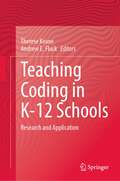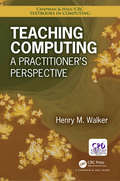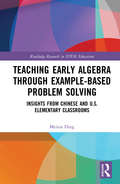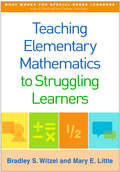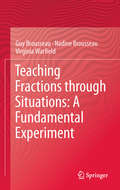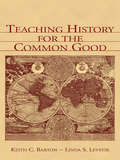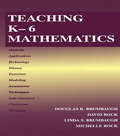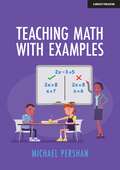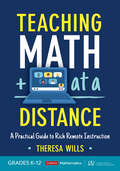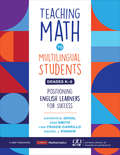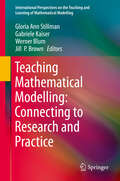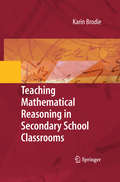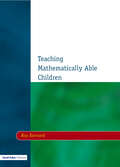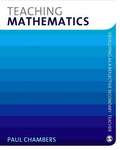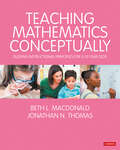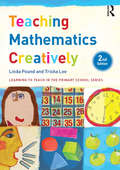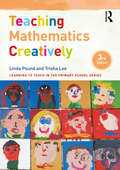- Table View
- List View
Teaching Coding in K-12 Schools: Research and Application
by Therese Keane Andrew E. FluckThis book contains highly effective ways to teach coding and computational thinking skills throughout primary and secondary schooling. It outlines a research informed path for students from birth to 18 years, identifying key skills and learning activities. Based on global perspectives and research at each stage, it outlines how these findings can be applied in the classroom. Teaching coding to students in K-12 has been a skillset that has been debated across educational jurisdictions globally for some time. The book provides examples of schools that are teaching coding to students in engaging and relevant ways, delivering well thought out compulsory curriculums. Additionally, it provides examples of schools where coding is not mandated in the curriculum and is taught in an ad-hoc manner. Through the full discussion of all of these varied examples, the book presents both sides of the serious and ongoing debate in the field as to whether coding should be taught in an explicit way at all. The increasing school of thought that teaching coding is a skill that is already obsolete, and the focus should be on computational thinking is completely examined and presented. In this book, both sides of the argument, as well as the specific, meticulous research underlying each side, are given equal weight. The debate is a serious one and requires a clearly defined thematic response with evidence on all sides of the argument presented rationally. This book does just that. Created by carefully selected authors from around the world, it will be a highly studied research reference.
Teaching Computing: A Practitioner's Perspective
by Henry M. WalkerTeaching can be intimidating for beginning faculty. Some graduate schools and some computing faculty provide guidance and mentoring, but many do not. Often, a new faculty member is assigned to teach a course, with little guidance, input, or feedback. Teaching Computing: A Practitioner’s Perspective addresses such challenges by providing a solid resource for both new and experienced computing faculty. The book serves as a practical, easy-to-use resource, covering a wide range of topics in a collection of focused down-to-earth chapters. Based on the authors’ extensive teaching experience and his teaching-oriented columns that span 20 years, and informed by computing-education research, the book provides numerous elements that are designed to connect with teaching practitioners, including: A wide range of teaching topics and basic elements of teaching, including tips and techniques Practical tone; the book serves as a down-to-earth practitioners’ guide Short, focused chapters Coherent and convenient organization Mix of general educational perspectives and computing-specific elements Connections between teaching in general and teaching computing Both historical and contemporary perspectives This book presents practical approaches, tips, and techniques that provide a strong starting place for new computing faculty and perspectives for reflection by seasoned faculty wishing to freshen their own teaching.
Teaching Data Analytics: Pedagogy and Program Design (Data Analytics Applications)
by Susan A Vowels Katherine Leaming GoldbergThe need for analytics skills is a source of the burgeoning growth in the number of analytics and decision science programs in higher education developed to feed the need for capable employees in this area. The very size and continuing growth of this need means that there is still space for new program development. Schools wishing to pursue business analytics programs intentionally assess the maturity level of their programs and take steps to close the gap. Teaching Data Analytics: Pedagogy and Program Design is a reference for faculty and administrators seeking direction about adding or enhancing analytics offerings at their institutions. It provides guidance by examining best practices from the perspectives of faculty and practitioners. By emphasizing the connection of data analytics to organizational success, it reviews the position of analytics and decision science programs in higher education, and to review the critical connection between this area of study and career opportunities. The book features: A variety of perspectives ranging from the scholarly theoretical to the practitioner applied An in-depth look into a wide breadth of skills from closely technology-focused to robustly soft human connection skills Resources for existing faculty to acquire and maintain additional analytics-relevant skills that can enrich their current course offerings. Acknowledging the dichotomy between data analytics and data science, this book emphasizes data analytics rather than data science, although the book does touch upon the data science realm. Starting with industry perspectives, the book covers the applied world of data analytics, covering necessary skills and applications, as well as developing compelling visualizations. It then dives into pedagogical and program design approaches in data analytics education and concludes with ideas for program design tactics. This reference is a launching point for discussions about how to connect industry’s need for skilled data analysts to higher education’s need to design a rigorous curriculum that promotes student critical thinking, communication, and ethical skills. It also provides insight into adding new elements to existing data analytics courses and for taking the next step in adding data analytics offerings, whether it be incorporating additional analytics assignments into existing courses, offering one course designed for undergraduates, or an integrated program designed for graduate students.
Teaching Early Algebra through Example-Based Problem Solving: Insights from Chinese and U.S. Elementary Classrooms (Routledge Research in STEM Education)
by Meixia DingDrawing on rich classroom observations of educators teaching in China and the U.S., this book details an innovative and effective approach to teaching algebra at the elementary level, namely, "teaching through example-based problem solving" (TEPS). Recognizing young children’s particular cognitive and developmental capabilities, this book powerfully argues for the importance of infusing algebraic thinking into early grade mathematics teaching and illustrates how this has been achieved by teachers in U.S. and Chinese contexts. Documenting best practice and students’ responses to example-based instruction, the text demonstrates that this TEPS approach – which involves the use of worked examples, representations, and deep questions – helps students learn and master fundamental mathematical ideas, making it highly effective in developing algebraic readiness and mathematical understanding. This text will benefit post-graduate students, researchers, and academics in the fields of mathematics, STEM, and elementary education, as well as algebra research more broadly. Those interested in teacher education, classroom practice, and developmental and cognitive psychology will also find this volume of interest.
Teaching Elementary Mathematics to Struggling Learners
by Mary E. Little Bradley S. WitzelPacked with effective instructional strategies, this book explores why certain K-5 students struggle with math and provides a framework for helping these learners succeed. The authors present empirically validated practices for supporting students with disabilities and others experiencing difficulties in specific areas of math, including problem solving, early numeracy, whole-number operations, fractions, geometry, and algebra. Concrete examples, easy-to-implement lesson-planning ideas, and connections to state standards, in particular the Common Core standards, enhance the book's utility. Also provided is invaluable guidance on planning and delivering multi-tiered instruction and intervention.
Teaching Foundation Mathematics: A Guide for Teachers of Older Students with Learning Difficulties (nasen spotlight)
by Nadia Naggar-SmithThis fully photocopiable resource will provide essential materials for anyone teaching pre-entry or foundation Maths in secondary schools and further education. Teaching Foundation Mathematics is developed to provide age appropriate material for adult learners with moderate to severe learning difficulties and/or disabilities and for children, over twelve, with special needs. It will also prove useful to teachers training to work with these learners. Thirty ready-to-use lessons are at your fingertips in this book, complete with tutor’s notes, teaching objectives, detailed lesson plans and photocopiable worksheets, where appropriate. The lessons are divided into three areas – number, shape and measure.
Teaching Fractions and Ratios for Understanding: Essential Content Knowledge and Instructional Strategies for Teachers
by Susan J. LamonWritten in a user-friendly, conversational style, the fourth edition of this groundbreaking text helps pre-service and in-service mathematics teachers build the comfort and confidence they need to begin talking to children about fractions and ratios, distilling complex ideas and translating research into usable ideas for the classroom. For two decades, Teaching Fractions and Ratios for Understanding has pushed readers beyond the limits of their current understanding of fractions and rational numbers, challenging them to refine and explain their thinking without falling back on rules and procedures they have relied on throughout their lives. All of the material offered in the book has been used with students, and is presented so that readers can see the brilliance of their insights as well as the issues that challenge their understanding. Each chapter includes children’s strategies and samples of student work for teacher analysis, as well as activities for practicing each thinking strategy, designed to be solved without rules or algorithms, using reasoning alone. The fourth edition of this popular text has been updated throughout and includes new examples of student work, updated artwork, and more. As with previous editions, an equally valuable component of this text is the companion book MORE! Teaching Fractions and Ratios for Understanding (2012), a supplement that is not merely an answer key but a resource that provides the scaffolding for the groundbreaking approach to fraction and ratio instruction explored here. MORE! includes in-depth discussions of selected problems in the main text, supplementary activities, Praxis preparation questions, more student work, and templates for key manipulatives.
Teaching Fractions through Situations: A Fundamental Experiment
by Virginia Warfield Nadine Brousseau Guy BrousseauThis work presents one of the original and fundamental experiments of Didactique, a research program whose underlying tenet is that Mathematics Education research should be solidly based on scientific observation. Here the observations are of a series of adventures that were astonishing for both the students and the teachers: the reinvention of fractions and of decimal numbers in a sequence of lessons and situations that permitted the students to construct the concepts for themselves. The book leads the reader through the highlights of the sequence's structure and some of the reasoning behind the lesson choices. It then presents explanations of some of the principal concepts of the Theory of Situations. In the process, it offers the reader the opportunity to join a lively set of fifth graders as they experience a particularly attractive set of lessons and master a topic that baffles many of their contemporaries.
Teaching Gifted Learners in STEM Subjects: Developing Talent in Science, Technology, Engineering and Mathematics (Routledge Research in Achievement and Gifted Education)
by Keith S. Taber Manabu Sumida Lynne McClureThis book offers an overview of programmes designed to support the learning of gifted and talented students in STEM subjects, both to allow them to meet their potential and to encourage them to proceed towards careers in STEM areas. The chapters from a range of national contexts report on perspectives, approaches and projects in gifted education in STEM subjects. These contributions provide a picture of the state of research and practice in this area, both to inform further research and development, and to support classroom teachers in their day-to-day work. Chapters have been written with practitioners in mind, but include relevant scholarly citations to the literature. The book includes some contributions illustrating research and practice in specific STEM areas, and others which bridge across different STEM subjects. The volume also includes an introductory theoretical chapter exploring the implications for gifted learners of how 'STEM' is understood and organized within the school curriculums.
Teaching History for the Common Good
by Keith C. Barton Linda S. LevstikIn Teaching History for the Common Good, Barton and Levstik present a clear overview of competing ideas among educators, historians, politicians, and the public about the nature and purpose of teaching history, and they evaluate these debates in light of current research on students' historical thinking. In many cases, disagreements about what should be taught to the nation's children and how it should be presented reflect fundamental differences that will not easily be resolved. A central premise of this book, though, is that systematic theory and research can play an important role in such debates by providing evidence of how students think, how their ideas interact with the information they encounter both in school and out, and how these ideas differ across contexts. Such evidence is needed as an alternative to the untested assumptions that plague so many discussions of history education. The authors review research on students' historical thinking and set it in the theoretical context of mediated action--an approach that calls attention to the concrete actions that people undertake, the human agents responsible for such actions, the cultural tools that aid and constrain them, their purposes, and their social contexts. They explain how this theory allows educators to address the breadth of practices, settings, purposes, and tools that influence students' developing understanding of the past, as well as how it provides an alternative to the academic discipline of history as a way of making decisions about teaching and learning the subject in schools. Beyond simply describing the factors that influence students' thinking, Barton and Levstik evaluate their implications for historical understanding and civic engagement. They base these evaluations not on the disciplinary study of history, but on the purpose of social education--preparing students for participation in a pluralist democracy. Their ultimate concern is how history can help citizens engage in collaboration toward the common good. In Teaching History for the Common Good, Barton and Levstik: *discuss the contribution of theory and research, explain the theory of mediated action and how it guides their analysis, and describe research on children's (and adults') knowledge of and interest in history; *lay out a vision of pluralist, participatory democracy and its relationship to the humanistic study of history as a basis for evaluating the perspectives on the past that influence students' learning; *explore four principal "stances" toward history (identification, analysis, moral response, and exhibition), review research on the extent to which children and adolescents understand and accept each of these, and examine how the stances might contribute to--or detract from--participation in a pluralist democracy; *address six of the principal "tools" of history (narrative structure, stories of individual achievement and motivation, national narratives, inquiry, empathy as perspective-taking, and empathy as caring); and *review research and conventional wisdom on teachers' knowledge and practice, and argue that for teachers to embrace investigative, multi-perspectival approaches to history they need more than knowledge of content and pedagogy, they need a guiding purpose that can be fulfilled only by these approaches--and preparation for participatory democracy provides such purpose. Teaching History for the Common Good is essential reading for history and social studies professionals, researchers, teacher educators, and students, as well as for policymakers, parents, and members of the general public who are interested in history education or in students' thinking and learning about the subject.
Teaching K-6 Mathematics
by David Rock Douglas K. Brumbaugh Linda S. Brumbaugh Michelle Lynn RockThis developmentally sound, research-based, practical text speaks directly to preservice elementary mathematics students about the multitude of ways they can help their future students learn to see the power, beauty, necessity, and usefulness of mathematics in the world.Part 1 deals with guiding principles that permeate the text, while Parts 2-11 deal with the specific NCTM Standards for grades K-6. Teaching K-6 Mathematics: *is aligned with the current NCTM Curriculum and Evaluation Standards for School Mathematics; *integrates content and methodology; *emphasizes use of technology as a teaching/learning tool; *stresses problem solving; *provides basic information on current research in mathematics education; *focuses on identification of error patterns and analysis; *uses a down-to-earth, friendly writing style that engages the student rather than prescribing what to do; and *includes many activities and exercises, including games, tricks, and amusements that can be used in the classroom to increase student interest in mathematics. Features: *Technology is integral throughout the text. Students are expected to perform Internet searches, investigate new sites appropriate for elementary students, sample new software that could be used in the classroom, and develop ways to blend calculators into the curriculum. *Manipulatives are considered essential for students to learn elementary mathematics concepts. Cuisenaire rods, base 10- blocks, chips, number lines, and geoboards are all part of the manipulative landscape that is created in this text. *Careful attention is given to blending rote work, developmental activities, fun, application, technology, manipulatives, assessment, and planning, so that prospective teachers become accustomed to using varied approaches and decision making as a curriculum is determined. *Tricks, Activities, and Games (TAG) provide a wealth of ideas to attract students to learning mathematics.
Teaching Math With Examples
by Michael PershanSome teachers think that there’s little to say about teaching with examples – after all, everyone uses them. But here are just some of the questions you might have about teaching with worked examples:How do we introduce an example?What do we ask students to do when studying a solution?Should a solution be presented all at once or revealed step-by-step?After we study an example, what comes next?Does it matter if the solution is presented as if from a fictional student, a real student in class, or from the teacher?How do we help students move from understanding someone else’s ideas towards using it on their own to solve problems?How do we write a solution in a clear way, that students can learn from?When is a good time to offer a worked example? When is it better to let students try a problem?Are worked examples more useful for some mathematical content than others?This book will answer all of these questions. In some cases, research offers answers. Other questions represent gaps in the research literature and the book offers solutions arrived at through experience and trial-and-error and the author’s own process of classroom problem solving.Welcome to the world of teaching with examples!
Teaching Math With Examples
by Michael PershanSome teachers think that there’s little to say about teaching with examples – after all, everyone uses them. But here are just some of the questions you might have about teaching with worked examples:How do we introduce an example?What do we ask students to do when studying a solution?Should a solution be presented all at once or revealed step-by-step?After we study an example, what comes next?Does it matter if the solution is presented as if from a fictional student, a real student in class, or from the teacher?How do we help students move from understanding someone else’s ideas towards using it on their own to solve problems?How do we write a solution in a clear way, that students can learn from?When is a good time to offer a worked example? When is it better to let students try a problem?Are worked examples more useful for some mathematical content than others?This book will answer all of these questions. In some cases, research offers answers. Other questions represent gaps in the research literature and the book offers solutions arrived at through experience and trial-and-error and the author’s own process of classroom problem solving.Welcome to the world of teaching with examples!
Teaching Math at a Distance, Grades K-12: A Practical Guide to Rich Remote Instruction (Corwin Mathematics Series)
by Theresa E. WillsMake Rich Math Instruction Come to Life Online In an age when distance learning has become part of the "new normal," educators know that rich remote math teaching involves more than direct instruction, online videos, and endless practice problems on virtual worksheets. Using both personal experience and those of teachers in real K-12 online classrooms, distance learning mathematics veteran Theresa Wills translates all we know about research-based, equitable, rigorous face-to-face mathematics instruction into an online venue. This powerful guide equips math teachers to: Build students’ agency, identity, and strong math communities Promote mathematical thinking, collaboration, and discourse Incorporate rich mathematics tasks and assign meaningful homework and practice Facilitate engaging online math instruction using virtual manipulatives and other concrete learning tools Recognize and address equity and inclusion challenges associated with distance learning Assess mathematics learning from a distance With examples across the grades, links to tutorials and templates, and space to reflect and plan, Teaching Math at a Distance offers the support, clarity, and inspiration needed to guide teachers through teaching math remotely without sacrificing deep learning and academic growth.
Teaching Math at a Distance, Grades K-12: A Practical Guide to Rich Remote Instruction (Corwin Mathematics Series)
by Theresa E. WillsMake Rich Math Instruction Come to Life Online In an age when distance learning has become part of the "new normal," educators know that rich remote math teaching involves more than direct instruction, online videos, and endless practice problems on virtual worksheets. Using both personal experience and those of teachers in real K-12 online classrooms, distance learning mathematics veteran Theresa Wills translates all we know about research-based, equitable, rigorous face-to-face mathematics instruction into an online venue. This powerful guide equips math teachers to: Build students’ agency, identity, and strong math communities Promote mathematical thinking, collaboration, and discourse Incorporate rich mathematics tasks and assign meaningful homework and practice Facilitate engaging online math instruction using virtual manipulatives and other concrete learning tools Recognize and address equity and inclusion challenges associated with distance learning Assess mathematics learning from a distance With examples across the grades, links to tutorials and templates, and space to reflect and plan, Teaching Math at a Distance offers the support, clarity, and inspiration needed to guide teachers through teaching math remotely without sacrificing deep learning and academic growth.
Teaching Math to Multilingual Students, Grades K-8: Positioning English Learners for Success (Corwin Mathematics Series)
by Kathryn Chval Erin Marie Smith Lina Trigos-Carrillo Rachel JaDean PinnowUsing strengths-based approaches to support development in mathematics It’s time to re-imagine what’s possible and celebrate the brilliance multilingual learners bring to today’s classrooms. Innovative teaching strategies can position these learners as leaders in mathematics. Yet, as the number of multilingual learners in North American schools grows, many teachers have not had opportunities to gain the competencies required to teach these learners effectively, especially in disciplines such as mathematics. Multilingual learners—historically called English Language Learners—are expected to interpret the meaning of problems, analyze, make conjectures, evaluate their progress, and discuss and understand their own approaches and the approaches of their peers in mathematics classrooms. Thus, language plays a vital role in mathematics learning, and demonstrating these competencies in a second (or third) language is a challenging endeavor. Based on best practices and the authors’ years of research, this guide offers practical approaches that equip grades K-8 teachers to draw on the strengths of multilingual learners, partner with their families, and position these learners for success. Readers will find: • A focus on multilingual students as leaders • A strength-based approach that draws on students’ life experiences and cultural backgrounds • An emphasis on maintaining high expectations for learners’ capacity for mastering rigorous content • Strategies for representing concepts in different formats • Stop and Think questions throughout and reflection questions at the end of each chapter • Try It! Implementation activities, student work examples, and classroom transcripts With case studies and activities that provide a solid foundation for teachers’ growth and exploration, this groundbreaking book will help teachers and teacher educators engage in meaningful, humanized mathematics instruction.
Teaching Math to Multilingual Students, Grades K-8: Positioning English Learners for Success (Corwin Mathematics Series)
by Kathryn Chval Erin Marie Smith Lina Trigos-Carrillo Rachel JaDean PinnowUsing strengths-based approaches to support development in mathematics It’s time to re-imagine what’s possible and celebrate the brilliance multilingual learners bring to today’s classrooms. Innovative teaching strategies can position these learners as leaders in mathematics. Yet, as the number of multilingual learners in North American schools grows, many teachers have not had opportunities to gain the competencies required to teach these learners effectively, especially in disciplines such as mathematics. Multilingual learners—historically called English Language Learners—are expected to interpret the meaning of problems, analyze, make conjectures, evaluate their progress, and discuss and understand their own approaches and the approaches of their peers in mathematics classrooms. Thus, language plays a vital role in mathematics learning, and demonstrating these competencies in a second (or third) language is a challenging endeavor. Based on best practices and the authors’ years of research, this guide offers practical approaches that equip grades K-8 teachers to draw on the strengths of multilingual learners, partner with their families, and position these learners for success. Readers will find: • A focus on multilingual students as leaders • A strength-based approach that draws on students’ life experiences and cultural backgrounds • An emphasis on maintaining high expectations for learners’ capacity for mastering rigorous content • Strategies for representing concepts in different formats • Stop and Think questions throughout and reflection questions at the end of each chapter • Try It! Implementation activities, student work examples, and classroom transcripts With case studies and activities that provide a solid foundation for teachers’ growth and exploration, this groundbreaking book will help teachers and teacher educators engage in meaningful, humanized mathematics instruction.
Teaching Mathematical Modelling: Connecting to Research and Practice
by Gabriele Kaiser Werner Blum Gloria Ann Stillman Jill P. BrownThis book provides readers with an overview of recent international research and developments in the teaching and learning of modelling and applications from a variety of theoretical and practical perspectives. There is a strong focus on pedagogical issues for teaching and learning of modelling as well as research into teaching and practice. The teaching of applications of mathematics and mathematical modelling from the early years through primary and secondary school and at tertiary level is rising in prominence in many parts of the world commensurate with an ever-increasing usage of mathematics in business, the environment, industry and everyday life. The authors are all members of the International Community of Teachers of Mathematical Modelling and Applications and important researchers in mathematics education and mathematics. The book will be of interest to teachers, practitioners and researchers in universities, polytechnics, teacher education, curriculum and policy.
Teaching Mathematical Reasoning in Secondary School Classrooms
by Nico Molefe Stephen Modau Lorraine Lauf Romulus O'Brien Karin Brodie Kurt CoetzeeFor too many students, mathematics consists of facts in a vacuum, to be memorized because the instructor says so, and to be forgotten when the course of study is completed. In this all-too-common scenario, young learners often miss the chance to develop skills--specifically, reasoning skills--that can serve them for a lifetime. The elegant pages of Teaching Mathematical Reasoning in Secondary School Classrooms propose a more positive solution by presenting a reasoning- and discussion-based approach to teaching mathematics, emphasizing the connections between ideas, or why math works. The teachers whose work forms the basis of the book create a powerful record of methods, interactions, and decisions (including dealing with challenges and impasses) involving this elusive topic. And because this approach shifts the locus of authority from the instructor to mathematics itself, students gain a system of knowledge that they can apply not only to discrete tasks relating to numbers, but also to the larger world of people and the humanities. A sampling of the topics covered: Whole-class discussion methods for teaching mathematics reasoning. Learning mathematical reasoning through tasks. Teaching mathematics using the five strands. Classroom strategies for promoting mathematical reasoning. Maximizing student contributions in the classroom. Overcoming student resistance to mathematical conversations. Teaching Mathematical Reasoning in Secondary School Classrooms makes a wealth of cutting-edge strategies available to mathematics teachers and teacher educators. This book is an invaluable resource for researchers in mathematics and curriculum reform and of great interest to teacher educators and teachers.
Teaching Mathematically Able Children
by Roy KennardThis work aims to help primary and secondary teachers to recognize and teach mathematically able pupils. Roy Kennard reviews the characteristics of the very able pupils and shows how these characteristics are reflected in the National Curriculum for Mathematics. He goes on to show how: mathematically able children can be challenged through problem solving and interactive discussion; and the use of in-depth case studies and other examples of pupils' work makes it possible for teachers to see the consequences of the approaches discussed. This text also considers whole school organizational and leadership approaches and should be useful to school management teams or "gifted and talented coordinators." This revised and updated second edition should be of interest to teachers, advisers, lecturers and students with an interest in securing effective provision for mathematically able pupils.
Teaching Mathematics
by Paul ChambersReflective practice is at the heart of effective teaching, and this book helps you develop into a reflective teacher of mathematics. Everything you need is here: guidance on developing your analysis and self-evaluation skills, the knowledge of what you are trying to achieve and why, and examples of how experienced teachers deliver successful lessons. The book shows you how to plan lessons, how to make good use of resources and how to assess pupils' progress effectively. Each chapter contains points for reflection, which encourage you to break off from your reading and think about the challenging questions that you face as a new teacher. The book is supplemented by a companion website, with: " Videos of real lessons so you can see the skills discussed in the text in action " Links to a range of sites that provide useful additional support " Extra planning and resource materials. If you are training to teach mathematics this book will help you to improve your classroom performance, by providing you with practical advice, but also by helping you to think in depth about the key issues. It also provides examples of the research evidence that is needed in academic work at Masters level, essential for anyone undertaking an M-level PGCE. Paul Chambers was formerly course leader for PGCE mathematics at Edge Hill University.
Teaching Mathematics Conceptually: Guiding Instructional Principles for 5-10 year olds (Math Recovery)
by Beth L. MacDonald Jonathan N. ThomasThis book expands upon the guiding principles at the heart of Math Recovery® instruction, exploring their connections with learning theory, practical application in the classroom and their wider links to agreed concepts of high-quality mathematics teaching. It provides a well-rounded overview of all major aspects of mathematics teaching including inquiry-based and constructivist approaches, planning and assessment, and strategies that offer children opportunities for reflection, satisfaction and increasing challenge. Particular focus is placed on equitable and inclusive practices in mathematics and how we can develop teaching that connects with the abilities, cultures, and lived experiences of all children. This is essential reading for all teachers familiar with the Math Recovery® approach and classroom mathematics teachers in elementary and primary schools everywhere seeking to enhance their own professional knowledge and understanding. Beth L. MacDonald is an associate professor in Early Childhood Mathematics Education in the School of Teaching and Learning at Illinois State University. Jonathan N. Thomas is an associate professor of mathematics education and the chairperson of the Department of STEM Education at the University of Kentucky.
Teaching Mathematics Conceptually: Guiding Instructional Principles for 5-10 year olds (Math Recovery)
by Beth L. MacDonald Jonathan N. ThomasThis book expands upon the guiding principles at the heart of Math Recovery® instruction, exploring their connections with learning theory, practical application in the classroom and their wider links to agreed concepts of high-quality mathematics teaching. It provides a well-rounded overview of all major aspects of mathematics teaching including inquiry-based and constructivist approaches, planning and assessment, and strategies that offer children opportunities for reflection, satisfaction and increasing challenge. Particular focus is placed on equitable and inclusive practices in mathematics and how we can develop teaching that connects with the abilities, cultures, and lived experiences of all children. This is essential reading for all teachers familiar with the Math Recovery® approach and classroom mathematics teachers in elementary and primary schools everywhere seeking to enhance their own professional knowledge and understanding. Beth L. MacDonald is an associate professor in Early Childhood Mathematics Education in the School of Teaching and Learning at Illinois State University. Jonathan N. Thomas is an associate professor of mathematics education and the chairperson of the Department of STEM Education at the University of Kentucky.
Teaching Mathematics Creatively (Learning to Teach in the Primary School Series)
by Trisha Lee Linda PoundThis new and updated edition of Teaching Mathematics Creatively offers a range of strategies to enable trainee and practising teachers to take an innovative, playful and creative approach to maths teaching. It promotes creativity as a key element of practice and offers ideas to involve your students and develop knowledge, understanding and enjoyment. Exploring fresh approaches, this text explains the role of play in bringing mathematics alive for children and teachers alike. It identifies the power of story-telling in supporting mathematical thinking, examines cross-curricular teaching, and allows you to plan for teaching creatively. Imaginative ideas, underpinned by the latest research and theory, include: Learning maths outdoors - make more noise, make more mess or work on a larger scale Everyday maths - making sense of the numbers, patterns, shapes and measures children see around them Music and maths - the role of rhythm in learning, and music and pattern in maths Giant maths - how much food do you include on a giant shopping list? Stimulating and accessible, with contemporary and cutting-edge practice at the forefront, Teaching Mathematics Creatively includes a wealth of innovative ideas to enthuse teachers and enrich maths teaching. This book is an essential purchase for any professional who wishes to embed creative approaches to teaching in their classroom.
Teaching Mathematics Creatively (Learning to Teach in the Primary School Series)
by Trisha Lee Linda PoundThis revised and updated third edition offers a range of strategies, activities and ideas to bring mathematics to life in the primary classroom. Taking an innovative and playful approach to maths teaching, this book promotes creativity as a key element of practice and offers ideas to help your students develop knowledge, understanding and enjoyment of the subject. In the creative classroom, mathematics becomes a tool to build confidence, develop problem solving skills and motivate children. The fresh approaches explored in this book include a range of activities such as storytelling, music and construction, elevating maths learning beyond subject knowledge itself to enable students to see mathematics in a new way. Key chapters of this book explore: • Learning maths outdoors - make more noise, make more mess or work on a larger scale • Everyday maths - making sense of the numbers, patterns, shapes and measures children see around them • Music and maths – the role of rhythm in learning, and music and pattern in maths Stimulating, accessible and underpinned by the latest research and theory, this is essential reading for trainee and practising teachers who wish to embed creative approaches to maths teaching in their classroom.
